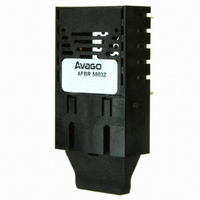AFBR-5803Z Avago Technologies US Inc., AFBR-5803Z Datasheet - Page 14

AFBR-5803Z
Manufacturer Part Number
AFBR-5803Z
Description
TXRX OPT 1X9 100MBPS DUPLEX SC
Manufacturer
Avago Technologies US Inc.
Datasheet
1.AFBR-5803ATZ.pdf
(16 pages)
Specifications of AFBR-5803Z
Data Rate
100Mbps
Wavelength
1300nm
Applications
General Purpose
Voltage - Supply
3.3V, 5V
Connector Type
SC
Mounting Type
Through Hole
Function
Implement FDDI and ATM at the 100 Mbps/125 MBd rate
Product
Transceiver
Pulse Width Distortion
0.69 ns (Max)/2.14 ns (Max)
Maximum Output Current
50 mA
Operating Supply Voltage
4.75 V to 5.25 V
Maximum Operating Temperature
+ 70 C
Minimum Operating Temperature
0 C
Lead Free Status / RoHS Status
Lead free / RoHS Compliant
For Use With
Multimode Glass
Lead Free Status / RoHS Status
Lead free / RoHS Compliant, Lead free / RoHS Compliant
Other names
516-1991
Receiver Optical and Electrical Characteristics
(AFBR-5803Z/5803TZ: T
(AFBR-5803AZ/AFBR-5803ATZ: T
Notes:
1. This is the maximum voltage that can be applied across the Differential Transmitter Data Inputs to prevent damage to the input ESD protection
2. The outputs are terminated with 50 W connected to V
3. The power supply current needed to operate the transmitter is provided to differential ECL circuitry. This circuitry maintains a nearly constant
4. This value is measured with the outputs terminated into 50 W connected to V
5. The power dissipation value is the power dissipated in the receiver itself. Power dissipation is calculated as the sum of the products of supply
6. This value is measured with respect to V
7. The output rise and fall times are measured between 20% and 80% levels with the output connected to V
8. Duty Cycle Distortion contributed by the receiver is measured at the 50% threshold using an IDLE Line State, 125 MBd (62.5 MHz square-wave),
9. Data Dependent Jitter contributed by the receiver is specified with the FDDI DDJ test pattern described in the FDDI PMD Annex A.5. The input
10. Random Jitter contributed by the receiver is specified with an IDLE Line State,125 MBd (62.5 MHz square-wave), input signal. The input optical
11. These optical power values are measured with the following conditions:
12. The Extinction Ratio is a measure of the modulation depth of the optical signal. The data “0” output optical power is compared to the data “1”
1
Parameter
Input Optical Power Minimum
at Window Edge
Input Optical Power Minimum
at Eye Center
Input Optical Power Maximum
Operating Wavelength
Duty Cycle Distortion Contributed by the
Receiver
Data Dependent Jitter Contributed by the
Receiver
Random Jitter Contributed by the Receiver
Signal Detect - Asserted
Signal Detect - Deasserted
Signal Detect - Hysteresis
Signal Detect Assert Time (off to on)
Signal Detect Deassert Time (on to off )
circuit.
current flow from the power supply. Constant current operation helps to prevent unwanted electrical noise from being generated and conducted
or emitted to neighboring circuitry.
-14 dBm average.
voltage and currents, minus the sum of the products of the output voltages and currents.
input signal. The input optical power level is -20 dBm average. See Application Information - Transceiver Jitter Section for further information.
optical power level is -20 dBm average. See Application Information - Transceiver Jitter Section for further information.
power level is at maximum “P
•
•
•
•
The average power value can be converted to a peak power value by adding 3 dB. Higher output optical power transmitters are available on
special request.
peak output optical power and expressed as a percentage. With the transmitter driven by a HALT Line State (12.5 MHz square-wave) signal, the
average optical power is measured. The data “1” peak power is then calculated by adding 3 dB to the measured average optical power. The data
“0” output optical power is found by measuring the optical power when the transmitter is driven by a logic “0” input. The extinction ratio is the
ratio of the optical power at the “0” level compared to the optical power at the “1” level expressed as a percentage or in decibels.
The Beginning of Life (BOL) to the End of Life (EOL) optical power degradation is typically 1.5 dB per the industry con-
vention for long wavelength LEDs. The actual degradation observed in Avago Technologies 1300 nm LED products is
< 1 dB, as specified in this data sheet.
Over the specified operating voltage and temperature ranges.
With HALT Line State, (12.5 MHz square-wave), input signal.
At the end of one meter of noted optical fiber with cladding modes removed.
A
IN Min.
= 0°C to +70°C, V
(W)”. See Application Information - Transceiver Jitter Section for further information.
CC
A
with the output terminated into 50 W connected to V
= -10°C to +85°C, V
CC
CC
Symbol
P
P
P
l
DCD
DDJ
RJ
P
P
P
AS_Max
ANS_Max
A
A
IN Min.
IN Min.
IN Max.
D
-2 V.
= 3.135 V to 3.5 V or 4.75 V to 5.25 V)
- P
D
(W)
(C)
CC
Min.
-14
1270
P
dB
-45
1.5
0
0
D
= 3.135 V to 3.5 V or 4.75 V to 5.25 V)
+ 1.5
Typ.
-33.9
-35.2
2
8
CC
- 2 V and an Input Optical Power level of
CC
Max.
-31
-31.8
1380
0.4
1.0
2.14
-33
100
350
- 2 V.
CC
-2 V through 50 W.
Unit
dBm avg.
dBm avg.
dBm avg.
nm
ns p-p
ns p-p
ns p-p
dBm avg.
dBm avg.
dB
µs
µs
Reference
Note 19
Figure 11
Note 20
Figure 11
Note 19
Note 8
Note 9
Note 10
Note 21, 22
Figure 12
Note 23, 24
Figure 12
Figure 12
Note 21, 22
Figure 12
Note 23, 24
Figure 12




















